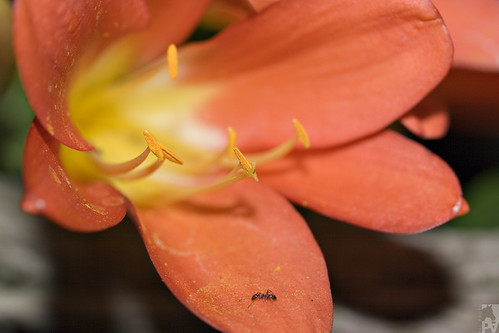
Clivia es un género de monocotiledóneas oriundas de África meridional. Son perennes no leñosas, con hojas de color verde oscuro, largas y estrechas que producen racimos de flores acampanadas rojas o anaranjadas al final de un largo tallo, asemejándose a los lirios. De las 6 especies conocidas, Clivia miniata y sus variedades híbridas son las más ampliamente cultivadas, con flores que oscilan entre el rojo anaranjado oscuro al amarillo pálido.
Se cultivan particularmente en Bélgica, Francia y China. Son plantas acaules, imperfectamente bulbosas, provistas de gruesas raíces fasciculadas. Las hojas son lineal-oblongas, planas, coriáceas. Las flores son hermafroditas, actinomorfas o ligeramente zigomorfas. El perigonio está compuesto por 6 tépalos unidos en la base formando un corto tubo y los segmentos son extendidos o rectos. El androceo está formado por 6 estambres, insertos en la garganta del perigonio, los filamentos son filiformes y las anteras son oblongas, dorsifijas. El ovario es ínfero, trilocular, con los lóculos 3-5 ovulados. El estilo es filiforme y el estigma es tripartido. El fruto es una baya globosa. Las flores se disponen en umbelas plurifloras en la extremidad de un escapo central, plano, áfilo, algo más largo que las hojas.
_____________________________________________________________________________
Clivia is a genus of monocot flowering plants native to southern Africa. They are from the family Amaryllidaceae. Common names include Kaffir lily and bush lily.
They are herbaceous evergreen plants, with dark green, strap-like leaves. Flowers are bell-shaped flowers on a stalk above the foliage, and they are borne in whites through yellow to red colours.
Of the six known species, Clivia miniata is the most widely cultivated, and hybrid varieties with flowers ranging from deep red-orange to pale yellow have been bred by growers.
C. miniata, C. gardenii, C. robusta and C. caulescens seedlings flower after three to four years, while the yellow varieties may take longer. C. nobilis will flower after seven or eight years. It is reported that C. mirabilis also takes about 6 years to flower.
Specimens were gathered by British explorers William Burchell and John Bowie in 1815 and 1820, respectively. Clivia nobilis became the first named species when in 1828 the Kew botanist John Lindley named it in honor of Lady Charlotte Florentia Clive, Duchess of Northumberland (1787-1866), who was for a time the governess of the future Queen Victoria.
